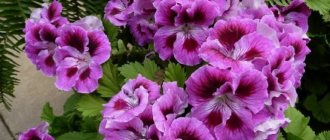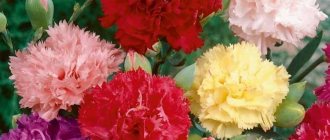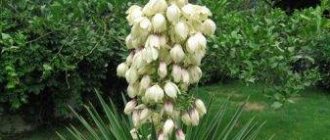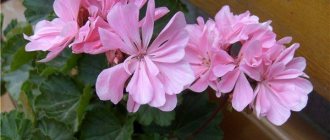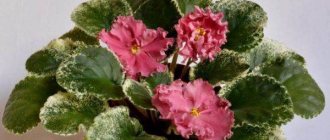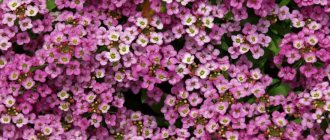When and how does it bloom
The flowering of royal geranium causes true delight among gardeners. She can not only look great, but also exude an amazingly subtle aroma.
Types of flowers
Royal geranium flowers can be not only classic, but also double. There are even specimens with corrugated inflorescences. The variety of their colors is simply amazing. The following shades can be presented:
- yellow;
- pink;
- red;
- violet;
- orange;
- white.
Royal geraniums have a rich range of colors
Flower shapes
The royal flower mostly has flat and concave petals on the inflorescences, but in some varieties they are wavy. This makes the plants even more attractive and sophisticated.
Flowering period
Unlike other varieties, royal geraniums do not have such a long flowering period. Its duration does not exceed six months. The beginning of flowering coincides with the onset of spring.
How to make it bloom at home
In order for royal geranium to bloom at home, its pot must be a little cramped. The plant also needs a period of rest. Otherwise, it will weaken and will not drown in flowers in the next season. Timely application of fertilizers, normalized watering and sufficient lighting levels are also necessary conditions for flowering.
Pruning for lush flowering
Before the onset of the dormant period, the main stem of royal geranium is shortened by a third of its length. This helps maintain the decorative appearance of the flower and also improves air circulation, which prevents the spread of fungi and pests.
Mandatory pruning is required for lush flowering.
Beneficial features
Essential oil
Homemade geranium is a medicinal plant. Healers claimed that she could cope with any illness: from ARVI to cancer. It is very often used in alternative medicine.
The folk epic says a lot about its benefits, for example, the proverb: “Geranium on the window - health in a basket.”
Let's consider its main properties in more detail:
- Modern scientists have studied its properties. It turned out that the aroma of pelargonium is bactericidal; it purifies the air in the room in which it is located.
- The aroma of the leaves repels insects. Everyone knows that it repels moths. Previously, clothes were arranged in sheets and put away for long-term storage.
- Normalizes blood pressure. To do this, the piece of paper is applied to the wrist.
- Treats colds. It is recommended to gargle with the infusion, and drop the juice from the leaves into the nose, 2 drops at a time.
- Relieves pain symptoms. The leaf is applied to the sore spot.
- Geranium essential oil has a calming effect on the nervous system.
- Using geranium oil you can relieve vasospasm.
- Normalizes heart function.
- Decoctions help with kidney and liver diseases.
- The roots of red pelargonium block the growth of cancerous tumors.
Lemon: description, care, growing from seeds at home, recipes for vitamin juice and lemonade (Photo & Video) + Reviews
Why doesn't the royal geranium bloom?
Many novice gardeners wonder why royal geraniums do not bloom. This may be a consequence of improper care, frequent transplants and the presence of bacterial and fungal infections. First of all, carefully inspect the plant for dark spots on the leaves, fuzz on the stems and rot in the root part. If signs of disease are found, then the entire root system should be cleared of soil, rinsed under running water and placed in a weak solution of potassium permanganate for 2 - 3 days. Clean or remove all affected parts of the plant.
Prepare fresh soil. If the same pot is to be used, disinfect it with a bleach solution. Before replanting, also disinfect the soil with boiling water. Replant the plant and carefully monitor the appearance of new signs of disease.
Also, royal geranium does not bloom if improper care and growth conditions are provided. For example, excessive dry air leads to the systematic falling off of buds and flower stalks. Their formation occurs only if the soil contains sufficient quantities of phosphorus, potassium and manganese. If nitrogen is applied in excess, green mass quickly increases and there is no flowering.
Another option why royal geranium pelargonium does not bloom is that the container in which the plant grows is too large. For this indoor flower, tall, but not wide, pots are more suitable. This ensures long-lasting abundant flowering. A large pot leads to the growth of green mass and lack of budding.
Top dressing
When feeding, fragrant pelargonium prefers fertilizers with nitrogen, potassium and phosphorus. The first month after planting, it is not necessary to apply fertilizer; the plant takes nutrients from the substrate.
It’s good if you use a granular mixture to feed geraniums. It will provide the plant with the necessary microelements for a long time.
Care for geraniums - tips
Despite the fact that pelargonium is an undemanding indoor flower, it nevertheless requires proper care. For full growth and abundant flowering, it will need good lighting, regular watering and frequent loosening of the soil. In addition to this, basic plant care includes fertilizing and removing faded buds and leaves. In order to get healthy and beautiful flowers, young bushes are pinched at the stage of appearance of several leaves. In order to get a densely branching bush, the plant is planted in a large pot. In small pots, geranium will delight you with rich flowering. Pelargonium, like many other indoor plants, is sold in pots filled with a soil substitute. It is not recommended to immediately replant a purchased flower in a new soil mixture. He will need 2-3 weeks to adapt.
The transplanted flowers are sprinkled with soil, without compacting them, watered a little. At first, the flowers are not fed.
Geranium is unpretentious to soil
When planting, it is extremely important to place a layer of drainage at the bottom of the pot. This will prevent rotting of the root system and stagnation of water at the bottom
Neutral and slightly alkaline soil is perfect for the growth of pelargonium. If you add a little ash to the soil, this will reduce its acidity. Leaf and turf soil mixed with sand and humus in equal proportions is an impeccable soil mixture for pelargoniums.
Proper care of flowers during the growing season is very important. It is not recommended to fertilize these flowers with organic fertilizers. Overfeeding can cause severe burns to plants. What they need is mineral fertilizers. They are rich in potassium, phosphorus and contain a very small percentage of nitrogen.
Pelargonium needs frequent and moderate watering. Before each moistening, the top layer of soil must dry out. In the cold season, flowers are watered no more than once every three days, in the summer - daily.
It is important to know that geranium cannot be sprayed. To increase air humidity in the room, place trays of water
Royal geranium tolerates dry air much worse than other varieties of pelargonium. This variety requires special care.
A well-lit place is the key to active growth and abundant flowering of geraniums. Lack of lighting can lead to houseplant disease, as well as a decrease in the number of flower buds.
In summer, when it’s hot, the flower should be placed in a shaded place to prevent the leaves from getting sunburn. South-facing window sills are an ideal place for growing geraniums.
With the onset of summer, pelargonium is planted in the garden in open ground, where it can delight with its decorative appearance and bright colors all season long. The main thing is to provide her with the proper conditions of detention and proper care. Geranium does not tolerate wind or drafts. In addition, an indoor flower planted in the shade will have small, faded leaves and is unlikely to bloom.
Peculiarities
When planning to grow royal pelargonium, it is recommended that you first become familiar with all its advantages and disadvantages.
| Positive traits | Negative qualities |
| It lends itself well to the propagation process. | It has a pungent and strong odor. If you stay in a room where pelargonium grows for too long, you may get a headache. |
| During the flowering stage, the plant is covered with a profuse number of flowers. | The plant is very capricious, so it must be carefully looked after. |
| It is permissible to cultivate both at home and in the garden. | |
| There is no need to transplant it into another pot too often. |
All varieties of royal pelargonium, photographs of which are presented in the article, have bright flowering. However, the plant is quite demanding, so the flower must be closely monitored so that it grows and develops normally.
Pelargonium is not geranium!
Surprised?
"How so? Everyone has been calling this flower geranium for 100 years, and our grandmothers called it that.”
The fact of the matter is that when our grandmothers were young, botanists were just beginning the process of classifying plants. First, the Geranium family (Geraniaceae) was identified, which included all plants whose fruit resembles the beak of a stork/crane (in Greek geranion - crane). And for all the plants there was one name - “geranium”.
Then the family was divided into genera, 2 of which are Pelargonium (Pelargonium) and Geranium (Geranium), there are 5 in total. These two genera are radically different from each other.
The genus Geranium is a winter-hardy plant that can overwinter in open ground and grows mainly in Europe. Unlike Pelargonium, they are practically not grown at home. There is also a difference in the shape of the flowers - geraniums have a regular, symmetrical flower structure.
Geranium
Pelargonium has an irregular flower shape - the top 2 petals are usually slightly larger than the bottom 3 petals. They grow in regions where the temperature does not drop below zero, so they will not withstand frosty winters in open ground.
Origin story
For the first time, bulbs of a new variety were discovered at the beginning of the 20th century in the mountains of Tibet, from where they quickly spread throughout the world.
The flower has several names - according to its place of origin, the lily is called Tibetan, and the Royal lily began to be called in the 20s of the last century, when the first varieties were bred - Tubular, Orleans. It is also known as the Florentine lily.
The flower was first used by the British botanist Wilson, who used it to decorate the Arnold Arboretum garden and was the first to describe it. For a long time, the lily ornament was a symbol of bohemia and royal families.
The peculiarity of the French royal lily is that it retains all varietal characteristics, regardless of the type of propagation - bulbous or seed.
Reproduction methods
Beginning flower growers are certainly interested in the question of how geranium propagates. To propagate geraniums, use the tops, which have 3-4 pairs of leaves. They are obtained at the time when the plant is pruned. Cuttings should not be rooted in water. High humidity does not promote root growth, but can only lead to them simply rotting. After cutting, processing is carried out using charcoal.
The cuttings are dried and immediately planted in the ground. By the way, propagation by cuttings of royal geranium is the simplest, most effective and widespread method.
To propagate with shoots, the soil for planting must contain perlite and peat in equal parts. The young plant is planted in a separate pot. You can also use a peat cup for this purpose. In this case, mass death due to improper care and reproduction is excluded. After 2 months, the plant will be completely rooted. Then it is transplanted into a nutrient substrate. Composition: turf, deciduous soil, sand, peat, taken in equal volumes. Covering with a jar or plastic bag is not required. Maintenance activities require regular watering and maintaining moderate light levels.
In order for geraniums to bloom magnificently and grow fully, periodic feeding is required. It is better if mineral fertilizers that have a low nitrogen content are used. When flowering begins, and it occurs 6-9 months after the plant has taken root, use the same fertilizers that are used to feed flowering indoor plants. They are sold in any store with this specialization.
American hybrids
American royal lilies were created by crossing varieties such as Humboldt, Canada and leopard, Paris and Bolander. The main, most common representatives of the American variety:
- Shuksan is a lily of unusual color. The main color is gold, with brown splashes. The edges of the petals are painted pink.
- Cherrywood - red flower.
American royal lilies are quite demanding in terms of soil composition, drainage and regular watering.
Considering the large number of flower varieties that can be crossed with each other, the American species has more than 150 varietal varieties.
American lily
general characteristics
Anyone who decides to seriously engage in this type of flowers will have to work hard, otherwise the expected result simply will not happen.
Truly “royal blood” actually flows in the stems and leaves of this type of geranium. Its homeland is South America, but this plant appeared in Europe only in the 8th century. It so happened that royal geranium achieved enormous popularity among flower growers in the shortest possible time. This plant is extremely interesting for breeders. As a result of their hard work, which does not stop literally for a minute, new varieties of royal pelargonium appear. Currently, there are such a large number of its varieties that it is quite difficult to name the exact number.
At home, pelargonium can reach a height of 60−80 cm. It is not worth growing bushes with a higher height, because the flowers are located only at the very top of the plant. If geranium grows to a height of 1 m, then it is characterized by the loss of all decorative properties. If you pursue only experimental goals, you can try to grow a bush up to 1.5 m high. Surrounded by low-growing plants, all the contrasting features will fully manifest themselves.
Planting and transplanting
Ivy geraniums need to be replanted every 2 years in the spring. Each time you replant, you need to change the pot so that it is slightly larger than the previous one. In this case, the composition of the soil should remain the same.
Procedure:
- Place drainage at the bottom of the pot. These could be broken bricks, pieces of foam.
- Remove the geranium along with the earthen lump from the old container. To facilitate this procedure, water the plant first, and when the water is absorbed, turn the pot over, holding the lump and plant with one hand, and the pot with the other.
- After removing the plant, you need to carefully examine the root system to ensure there is no damage or decay. Remove all suspicious parts with scissors so as not to touch healthy roots.
- Place the plant in a new pot, and fill the void between the walls and roots with a new and slightly moistened substrate.
- The soil near the root must be compacted well so that there are no voids.
- Water the plant with water at room temperature and place in the shade for 7 days.
- After a week, move the pot to a permanent place.
Plants are partners
The best flowers - partners for royal lilies:
- Echinops;
- ornamental cereals;
- geranium and peony;
- sage, buzulnik and echinacea;
- tulips, crocuses and daffodils;
- delphiniums.
Ideal neighbors for lilies are peonies and phlox. Compositions with such colors look best.
When planting in a rock garden, it is necessary to take into account the neighboring plantings - they should not be higher than the lilies, so as not to block them from light
Possible problems in growing
Even the most experienced gardeners are not one hundred percent protected from the problems that arise when growing royal geraniums. It's even more difficult for beginners.
Drops buds and leaves
If the leaves and buds of the royal geranium begin to fall off, then with a high probability we can say that the room is too hot and the air is very dry. Also, these symptoms sometimes indicate insufficient lighting. You will need to turn on the phytolamp, install a humidifier and take measures to reduce the temperature in the room. If the house is cool, then it is enough to limit yourself to additional lighting and monitor the humidity.
Due to the heat, the royal geranium sheds its leaves and buds
The leaves are turning pale
A change in the color of the leaf blade is provoked not only by a deficiency of microelements (in particular nitrogen), but also by a lack of light, as well as excess moisture. It is urgent to analyze these factors and eliminate the cause.
The tips of the leaves are drying out
This problem in royal geranium most often occurs due to moisture deficiency. You should increase the number of waterings and resort to air humidification, but you should not be too zealous.
The lower leaves fall off
The fact that the lower leaves begin to turn yellow and fall off is caused by both a lack of moisture or nutrients in the soil, as well as a lack of light and poor ventilation of the bush. This symptom also signals rotting of the root system, which can lead to the death of the flower.
Pests
The most dangerous pests for royal geraniums are:
- mite;
- weevils;
- whitefly;
- aphid.
Royal geranium is susceptible to pests
To get rid of parasites, you should wipe the inside of the leaf blade with chamomile infusion and leave the plant for a couple of hours, then rinse everything off. If such actions do not bring a positive result, use an insecticide. Step-by-step instructions for its use are contained in the attached documentation.
Other problems
Sometimes the trunk of the royal geranium begins to rot. This indicates that the plant is affected by blackleg. The development of this disease is caused by excessive watering or low temperatures. Sick plants need to be disposed of and the pot disinfected.
Sometimes gardeners wonder why geraniums are green but lethargic? First of all, you should immediately reduce watering. Otherwise, the flower will bleat with gray rot. The scarlet tint of the leaves indicates low temperatures or the presence of drafts.
Conditions of care
The plant places increased demands on its maintenance and cultivation. The emphasis should be placed on four basic rules:
The plant does not tolerate either excess or lack of moisture. It should be protected from direct sun and strong winds. Experienced gardeners do not recommend planting this flower in open ground for the summer. They obviously will not approve of such hardening. But you can take a pot of pelargonium out onto the balcony in the summer. It should be placed on the balcony so that it is not covered by partial shade, but also not exposed to direct sunlight. Otherwise, the plant may get sunburned. The plant does not tolerate conditions in which there is a lack of light. This species cannot live in darkness at all. If there is not enough light, it will stretch out so that it has no strength left to set buds. To get lush buds, the plant must be illuminated with special fluorescent lamps. A certain temperature regime is required. In winter, the temperature should be maintained between 12-15 degrees. The plant will experience discomfort if the room temperature exceeds 24 degrees. The most minimal unpleasant phenomenon will be its lack of flowering.
The extreme negative point would be a complete stop of growth. Due attention should be paid to activities related to watering. How intensively soil moisture is required depends on temperature conditions
In summer, watering should be done moderately and regularly. According to the recommendation of experienced gardeners, watering is not carried out from above, but requires pouring liquid into a tray. With overhead watering, the soil becomes compacted, and royal geranium tolerates this phenomenon very poorly. The water must be defended. A good solution would be to water with rainwater.
The drug Heteroauxin: instructions for use of the solution
If you comply with all these requirements, the plant will certainly reward you with good flowering. It will delight the gardener for a long time with its beautiful, excellent flowers.
Flower propagation methods
Geraniums can reproduce in a variety of ways. However, cuttings are considered the ideal option. This is the simplest and most effective procedure that helps preserve the characteristics of the variety.
In addition, there are the following options for breeding the crop:
- seed method;
- dividing the bush;
- shoots.
How to propagate geraniums from cuttings at home
Performing geranium cuttings is considered the most accessible and effective method. It allows you to preserve the varietal characteristics of the crop. In this case, the plant must be provided with suitable conditions. First of all, it needs high temperature and good lighting.
First you need to prepare the cuttings. To do this, shoots with a length of at least 10 cm are selected. The cut must be made in the middle, between two adjacent leaves. It is not recommended to immediately plant prepared cuttings in a pot. First, the sections should dry slightly. But don't dry them too much. After the sections have dried, they should be treated with wood ash or sorbent. This will help prevent infection from getting into damaged areas.
Important! When propagating a plant using this method, it is worth cutting off the lower leaves before planting the cuttings.
Propagating flowers by cuttings has many advantages.
Rooting methods
Planting cuttings can be done in dry soil or in water. In the first case, small containers are used, in the bottom of which it is necessary to make holes and organize a drainage layer. Loose soil is used as a substrate. To get it, you can mix turf, garden soil, sand, and humus. It is also permissible to use a universal substrate. It can be purchased in specialized stores.
It is permissible to root plants in water. In this case, the cuttings are placed in a vessel filled with water. It is recommended to first add a means to stimulate the appearance of roots. The cuttings should remain in water until the first roots form. Then they need to be planted in a pot in a permanent place.
Planting in the ground and further care
To transplant a crop into the soil, you need to make a hole in the container, place the stem in it and compact the soil
It is important to consider the composition of the substrate. It must contain peat or sand
It is important that the soil is as loose as possible. To stimulate growth processes, you can create a greenhouse effect for the plant. This is achieved using a plastic bag.
It is strictly forbidden to use fresh organic fertilizers for geraniums. These include manure and humus. This feeding will stop the flowering process. Complex mineral preparations are used to fertilize geraniums. To make flowering more lush and lasting, you should use products containing potassium.
Stable growth of a flower after propagation is impossible without microelements such as zinc, iron, calcium, etc. Fertilizers should be applied 2 times a month.
Important! In the summer heat, fertilizing is not applied. This is due to the fact that the plant is under stress.
Geranium tolerates any humidity parameters normally. It takes root well and develops, delighting with abundant and lush flowering
It is important to ensure that water does not get on the leaves of the plant.
When propagating geraniums by cuttings, you need to consider the following:
- For watering plants, you should use only warm water;
- Only withered bushes should be protected from the sun;
- The plant must be rooted at a temperature of +15 degrees;
- The flower can be propagated all year round, but maximum efficiency is achieved in the spring;
- When planting in groups, maintain an interval of 15-17 cm between plants. This will help achieve rapid flowering.
Geranium needs high-quality and proper watering
Young plants take root in different ways. It depends on the specific variety. Zonal and ivy-leaved crops take root the fastest. It takes a month for royal pelargonium to adapt. Fragrant geranium takes root in 1.5 months. At the same time, flowering of angelic and royal species occurs after a year.
Watering
When watering pelargoniums, it is important to remember that these are fairly drought-resistant plants, while at the same time easily susceptible to fungal diseases. Therefore, it is better to underwater the plant a little rather than overwater it.
In summer, water as the top layer dries, provided that the plant is in a warm and sunny place. In winter, in cool conditions, watering should be limited, but not allowed to completely dry out the soil.
Signs of excessive watering will be limp, drooping leaves, often with signs of gray rot; in severe cases, the stem will begin to rot, which almost always leads to the death of the plant. Another symptom of excess moisture is the appearance of “sores” on the underside of leaves. When the earthen clod dries out, the plant stops blooming, the leaves turn yellow, and their edges dry out.
Air humidity is not important for pelargoniums; these plants do not require spraying. Excessive dampness and stagnant air can cause fungal diseases.
Transfer rules
Royal geranium has a very unfavorable attitude towards various movements. Transplantation is carried out in exceptional cases. It is better not to disturb the plant at all. But it happens that you still have to seat them. For example, there may be cases in which the root system has grown so intensely that it simply no longer fits into the pot. In this case, of course, the plant must be replanted.
Transplantation is recommended every 2 years. If this requirement is not met, the plant may stop flowering or there will be a small number of flowers. The optimal time for transplantation is the very beginning of February. The soil should be prepared, which will consist of peat, deciduous soil, turf soil and river sand. Good drainage is essential. Expanded clay or river sand are best suited for this purpose.
Photo of royal geranium and description
In the proposed photos, royal geranium is presented in various variations of varieties and selections. This plant is a favorite among flower growers from all over the world. Therefore, new varieties with original petal colors are constantly appearing. Terry royal pelargoniums are more common. They have richly colored petals and a wide spherical cluster of peduncles.
In the photo of royal pelargonium you can see the Pink Mikado variety. It is distinguished by its compact bush size, rich dark green leaves and slightly pubescent stems. The color of the petals ranges from pastel pink to rich salmon. In the center of each petal there is a dark oval spot, which indicates royal pelargonium.
Royal pelargonium in the photo
The next photo shows Aristo Schoko, a variety of royal geranium that has a rich red petal color. In the center of the cervical part of each petal there is a bright oval-shaped spot of dark red color.
If you want an exotic look, then look at the photo of the royal geranium variety Barkarole. This is a bright variegated color with a real riot of colors. The edge of each petal, which has a silvery tint, gives the variety sophistication and exoticism. The edging of the buds in combination with bright yellow, orange, white and pink petals gives the royal geranium flower an attractive appearance. Widely used to create harmonious interior designs in apartments, country houses and offices.
For lovers of classic room design options, there is the Imperial variety. In the photo you can see compact plants with delicate beige petals, which are decorated with rich pink spots in the center.
Royal pelargonium was first brought to Europe at the end of the eighteenth century. Since then, selection work has been going on endlessly, as a result of which more and more new hybrid forms of this plant appear. Therefore, the varieties of royal geranium listed above are not a complete list. These are simply the most popular and sought after varieties.
A general description of royal geranium pelargonium includes information about the average height of an adult plant. In most cases, at home, royal pelargonium reaches a height of 60 - 80 cm. It is not advisable to grow a taller plant, since the buds are located only on the apical growth points. At a height of 1 meter, the decorative properties of an indoor flower are completely lost. However, in a garden, you can grow a one and a half meter bush as an experiment. But it is better to use it as a background for low-growing flowering plants.
The special chic of royal pelargonium, judging by the description and cultivation practice, is the inflorescence of buds. They can reach a width of up to 25 cm. But this is with proper care at home. On average, these are standard inflorescences with a diameter of up to 15 cm. The length of the peduncle can reach up to 10 cm. The more mineral fertilizers of the potassium and phosphorus group are added during the preparation for flowering, the larger the diameter of the inflorescence and the shorter the length of the peduncle.
A distinctive characteristic is the presence of a dark, richly colored oval spot in the center of each petal. In terms of their structure, royal pelargonium flowers can be either simple or double. The shape of the petals can be with a slight wave-like structure or flat concave. There are forms of corrugated flowers of royal geranium. The leaves are serrated, oval or round. The leaf has a rough surface with slight pubescence. The color of the foliage depends on the condition of the plant. A healthy indoor flower has rich emerald foliage that tightly covers the central trunk and all shoots.
Shades of buds can include dazzling white, red, pink, purple, yellow, and orange. The flowering period is not long and lasts a maximum of 6 months. The indoor flower royal geranium begins to bloom in early March.
How to propagate geranium
Seeds
Geranium propagation is carried out in two ways: using seeds and cuttings. The first method is less popular and more applicable for breeding new species of pelargonium. From seeds of a certain variety, plants with completely different decorative qualities can grow.
To plant seeds, take a soil mixture of loose soil, humus and sand. Sowing of planting material is carried out in early spring. For early planting, it is recommended to use artificial light lamps. To prevent diseases, the soil is disinfected before planting and spilled with a weak solution of potassium permanganate (potassium permanganate). The sown seeds must be sprinkled with a thin layer of soil - 2-3 mm. Further care of the seedlings consists of creating greenhouse conditions for their successful germination.
Trimming
The main work on pruning the plant is carried out in winter, when pelargonium actively reaches for the light and stretches its stems, breaking the compact shape of the bush. Without sparing, pinch the tops of the plant until March. At the beginning of April, pruning is stopped. The plant is preparing for flowering and is busy forming buds; do not disturb it at this time. In summer, pinching is carried out only to preserve the shape of the bush.
Pelargonium bushes moved into flower beds are an excellent design solution for the yard of a house in the mountains
